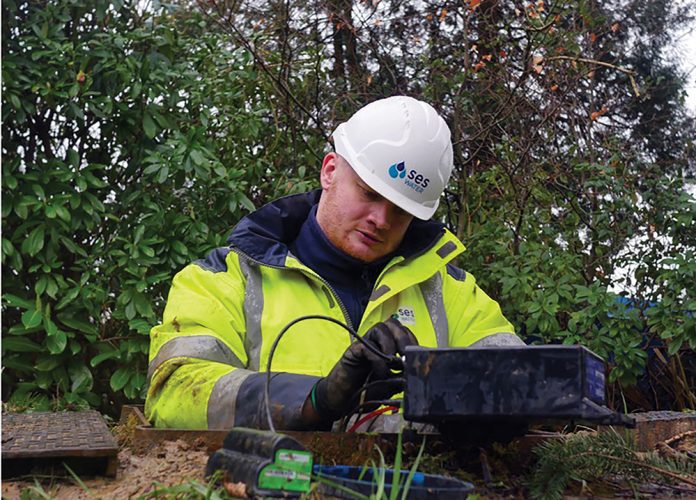The Company is the first in the UK industry to roll out intelligent technology across its entire water distribution network, with the aim of cutting leakage by 15 per cent over the next three years. Water Industry Journal finds out more.
SES Water’s self-learning technology is based on a network of sensors which relay data on leaks and bursts back to its operational teams minute by minute.
By highlighting issues in near real-time, field staff can get to the source of the leak even before customers know there’s a problem. Costing £1.1m to date, the network is part of the Company’s strategy to invest in innovative technologies and approaches to more than halve leakage by 2045.
SES Asset Data Lead, Jack Nicol, acknowledges that the imminent leak reduction target is “optimistic but achievable.”
He added: “We are working on several other innovative, exciting projects that will help us try and deliver the 15 per cent saving alongside traditional methods where we are still seeing good results. This is just one strategy we are employing alongside a suite of interventions and strategies to improve our leakage and network performance and sustainably reduce leakage over the short, medium and long term.”
Other benefits include a lower risk of pollution incidents and fewer unnecessary site visits, leading to lower carbon emissions.
SES Water Head of Asset Strategy, Daniel Woodworth, said: “This is a game-changing milestone, not just for us and our customers, but the water industry as a whole.
“We already have one of the lowest levels of leakage in the country, but we want and need to do more, and our intelligent network will significantly improve the way we manage leaks and help reduce the total amount of water lost each day. Not only will it minimise interruptions to supply for our customers, but it will also help us reduce the amount of water we take from the natural environment.”
Work on the project began mid-2018, but Covid hit just before rollout, pushing full implementation back to March this year. Jack explained: “The AI software must learn our data and national lockdowns don’t give it a true sense of reality. It has to learn what is normal to create a good prediction. We didn’t want our operational staff to have a tool that didn’t work.
“The technology has performed well since rollout began. This has been down to some great in-house training but also the operational teams have really been on-board and dedicated to making it work.
“Yes, it wasn’t in operation for pretty much the whole of 2021 but we were able to test the software thoroughly and retrospectively look back and see if it did detect leaks and bursts on the network. It gave us a chance to fine-tune the settings so we had it operating as well as it possibly could be when we trained our colleagues on the system.
“BURSTAlert is now live and running across the whole of the network, our control room is responding in near real time to alarms coming in from the sensors in the network, and as a company we are reacting faster and smarter to network issues.
“We continue to work with partner Royal Haskoning DHV on small software upgrades after some early feedback from the end users.
“BURSTFind is the next big thing we’re working on. This will not only alert us to a potential leak or burst before a customer calls it in it will localise it and allow us to dispatch our network inspectors or leakage teams to the right area of a DMA and reduce the leak detection time and in-turn the leak run time.” Trials are progressing really well and we hope to be implementing this next phase later this year.
Vodafone, Royal HaskoningDHV and Technolog are collaborating on the project. Vodafone supports the system with its Narrow Band Internet of Things (NB-IoT) service for efficient communication, long battery life and lower costs; Technolog sensors measure flow, pressure, transients and water temperature; and Royal HaskoningDHV provides AI-powered Aquasuite® technology for data analysis to enable near real-time operational decisions.
Jack explained: “Technolog were our existing logger supplier, and the partnerships came about through conversations at various conferences and seminars. We ran a selection process for RHDHV where we invited companies to present their AI software offering to us and assessed it against our vision for a smart network.
“Implementation started July 2019 with a proof of concept and then mass roll-out began in 2020 switching all sensors across the network to NB-IoT for near real-time data.
“Installation of sensors was completed in early 2021 and all sensors were successfully on-boarded to Royal Haskoning DHV’s Aquasuite platform.
“We currently have 725 NB-IoT sensors installed on the network these include ALL district meters, ALL critical points, and 92 additional Monitoring Points across 12 BURSTFind extended trial DMAs.”
Nick Gliddon, of Vodafone UK, said: “SES Water is showing how IoT can be used to achieve meaningful results, quickly”, while Technolog spokesman Luke Thornton, added: “We have supported SES Water with the supply of multi parameter Cello 4S data loggers and Regulo pressure control devices for many years and look forward to continuing this collaboration through AMP7, AMP8 and beyond.”



